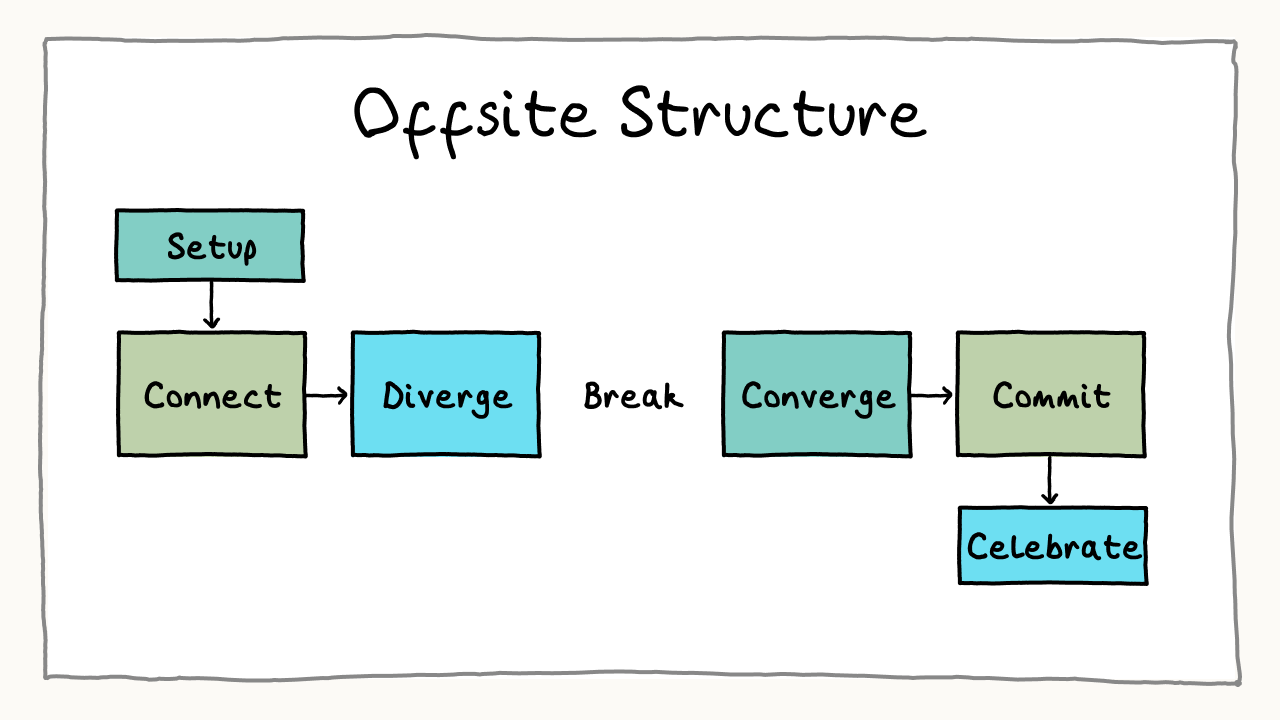How to Design an Amazing Strategy Offsite
Written by Dave Bailey
Successful strategy sessions tend to follow a common arc.
Most leadership teams come together for at least a few days each year to meet up as a team, align on the business strategy, and collaborate on the company’s biggest challenges. These meetings are often held offsite, as physical distance from day-to-day operations can make it easier to see the bigger picture.
The pressure to deliver something tangible can make setting the agenda an intimidating task. There are many topics you could discuss and alignment can seem a long way away. How can you make the best use of your team’s problem-solving abilities and arrive at something concrete?
I’ve created the following structure to help you design your agenda:

Let’s run through each section.
Part 1: Set up
It’s customary for the CEO to open the offsite with some inspiring words on the mission and vision of the company, and the purpose of the offsite. However, there are a couple of other activities that can ensure the offsite runs smoothly.
Firstly, establishing ground rules on how to behave, known as ‘contracting’, can help you avoid unproductive behaviours such as interrupting, waffling, or losing focus (often with a mobile phone in hand). Here are three questions that will help the group design their own ground rules:
- What behaviours must we commit to so we all get the most from this offsite?
- Do we give each other permission to reinforce these commitments?
- How should we reinforce them?
Injecting some creativity into setting and reinforcing ground rules can be helpful. For example, one of my clients uses the term ‘devil’s avocado’ to inject a little humour and make people more relaxed about challenging the consensus.
Secondly, presenting certain words and phrases can nudge the team into a more strategic mindset, known as ‘behavioural priming’. Here are some concepts that may help the team later on when they get into discussions:
- Embrace the Paradox Mindset: many strategic decisions are nuanced. When faced with an impossible ‘either or’, reframe as ‘both and’ to draw out the nuance.
- Choose clarity over certainty: waiting for certainty can lead to paralysis. If the data would take too long to collect, be ready to take bold decisions to move forward.
- Work on the business, not in the business: it’s easy to get hung up on details, especially when they involve you. Try to focus on the big picture.
- Silence means you disagree: we often interpret silence as passive agreement, when it’s actually the opposite. Investigating any silences can often surface contrary opinions that would otherwise remain unheard.
- Perfect is the enemy of done: strategy development is an iterative process. Remind people to strive for good enough, not perfect.
- Ego is the enemy: the right answer might not be your answer. Learn to let go of your ideas and listen to others.
Reflecting on how each of your cultural values can guide behaviours is another way to prime the team. And finally, remind the team that every leader is here for a reason, and all of their diverse perspectives and contributions are critical to the offsite’s success.
Part 2: Connect
Fostering connection in the group at an early stage early in the offsite helps you increase the sense of trust and psychological safety needed for healthy conflict and debate. You might include lunches and dinner for help leaders to get to know each other, but building connections is so important that I’d recommend also dedicating some ‘work hours’ to it too.
Activities that increase a sense of connection typically involve safe ways for the group to be vulnerable and share feelings and needs — and be heard. There are lots of team building ideas out there, but here are a few of my favourites:
- ‘One-question ice-breakers’: Effective questions are ones that allow people to share something about themselves, such as ‘What past event are you most proud of?’, ‘What’s something funny we might not know about you?’ or ‘What’s a significant event that helped you grow as a person?’. Everyone could answer the same question, or pick one out of a hat.
- ‘Diversity introductions’: Ask people to choose 2 or 3 different dimensions that impacted who they are today, and introduce themselves through those dimensions. These sessions can be very powerful.

- ‘Round-robin retrospectives’: I’ve written about leadership retrospectives before. They are a really quick way for people to get things off their chest, and provide practical insights to the group.
- ‘Emotional check-in’: Ask people to share how they are feeling about the offsite. For example, what are you excited about? What are you curious about? What are you nervous about?
To be clear, I’m not recommending you do all of these exercises — just that you make space for building connections before jumping into the workshops. It’s when people feel connected that real teamwork can begin.
Learn new skills every week ->
Part 3: Diverge
One of the most important ideas in creative problem solving (and hopefully there’s space for this in your offsite) is that divergent and convergent thinking are different cognitive modes:
- Divergent thinking is the process of coming up with new ideas and possibilities.
- Convergent thinking is associated with analysis, judgement, and decision-making.

These different modes are like oil and water — they don’t mix well. Instant judgement can make coming up with ideas feel unsafe, and coming up with new possibilities while planning can be equally unhelpful. So it’s best to separate the divergent and convergent topics distinctly and deliberately.
Divergent topics might include things like:
- Horizon scanning: looking at new possibilities and opportunities in a particular area of the business
- Brainstorming: collecting as many ideas as possible on a particular business problem
- Open discussions: discussing controversial or paradoxical questions that have no right answer
Presenting content can help share relative context with the team, but long presentations tend to suck the oxygen out of the room. That’s why good workshops mix up formats every 10–20 minutes to manage energy levels and increase engagement from the group. Here are some formats that can form the building blocks of workshops.
- Presentations: keep slides short, punchy and visual (tends to reduce energy in the room)
- Group discussions: for large teams, split into small groups to discuss (tends to increase energy in the room)
- Exercises and activities: make the steps as simple as possible (tends to increase energy in the room)
- Q&A: send out-of-scope questions to the 'parking lot' (tends to reduce energy in the room)
You can find more information about workshop design here.
For some people, divergent workshops that surface new ideas and open possibilities are exhilarating. However, for others, these conversations can be unsatisfying or even anxiety-inducing — particularly if their role involves operations. You can reassure your team that convergence is coming… just not yet.
Part 4: Converge
Divergent workshops surface new ideas and questions, while convergent workshops are designed to analyse and prioritise those ideas, and to make decisions.
It’s really worth having an extended break — a long lunch or ideally a night’s sleep — to separate the divergent and convergent sessions. This allows the dust to settle and helps people switch from a creative mindset to an analytical one.
Convergent topics might include:
- Analysis: assessing pros and cons, prioritising ideas, estimating effort (perhaps by using planning poker)
- Decision-making: empowering leaders to make decisions and build consensus
- Planning: taking decisions and forming action plans
It’s helpful to clarify the format of the output of each session ahead of time. For example, if you use OKRs, a table that allows people to clarify their objectives, key results and initiatives can help people stay on track.
In the convergent phase, an empowered CEO has a special role to play: to ensure the leaders’ outputs are aligned to each other — and to the strategy as a whole. This typically involves noticing any logical inconsistencies and coaching the team to figure out their differences. And in the case of a deadlock, the CEO’s decision goes.
If you’re a CEO looking to level up on strategy and communication, this coaching program may be of interest.
Learn new skills every week ->
Part 5: Commit
At this point, you’ve come together as a group, come up with new ideas, and made some important decisions. Now it’s time to lock it in, and make commitments as a group.
‘Disagree and commit’ has become a popular expression used by startup leaders — and it’s helpful to discuss it as a team at this stage. You can ask the team explicitly:
What does disagree and commit mean for us here?
Often, leaders will come to an agreement with the leadership team at the time, only to say to their team later: “this wasn’t my idea”. To me, ‘disagree and commit’ means getting behind ideas you may not agree with, helping them succeed, and bringing your team with you.
For this reason, it’s good practice to go round the room and get verbal sign-off on key decisions from every leader. Remember, silence means you disagree.
If there are any follow-up items or action points coming out of the offsite, these can be assigned at this point as well.
Part 6: Celebrate
A great way to end the offsite is by returning to the mission and vision you outlined in the introduction. Thank the team for their efforts and contributions, and congratulate them on a job well done. The more you tell your team they are capable of great things, the more they’ll believe it.
As a startup leader, you want to take every opportunity to celebrate the small wins — and aligning on a strategy and path forward is a big deal. When it comes to celebrations, a bit of planning goes a long way, so don’t make this an afterthought.

How to Prepare
It’ll be obvious by now that crafting a successful offsite takes preparation. While the CEO typically owns the high-level agenda, they’ll need to share the preparation work with their leaders. For example:
- Gathering data and preparing analysis
- Researching trends and learnings
- Running SWOT analysis in their area
- Supporting on workshop design and output templates
- Collecting customer stories
Customer stories are some of the most valuable resources you can bring to offsites. When each leader (i.e. sales, marketing, product) brings their own customer stories, it can make strategic issues come alive, and increase a sense of purpose. Your customers can’t be there, but their stories can.
Make It Your Own
I’m always amazed by the creativity my clients bring to their offsites. Amazing locations, exciting exercises and even special guests can bring a sense of ‘wow’ to the event. But when they reflect on the day, it was the sense of connection and the ability to converge on something concrete that stands out as most important.
I hope this structure helps you design a better offsite. If you have a tip or advice from your offsite experiences, reach out and let me know!
Further reading on offsites and strategy:
- Here’s an overview of the three questions mentioned in ‘Lay the Foundation’
- How can you build engaging workshops? This process makes workshop design simple and easy.
- What does strategy actually mean? This strategy framework can help you clarify your long-term plan.
Originally published Jul 28, 2021, updated Jul 11, 2023
Learn a new skill every week
Subscribe to my weekly newsletter and learn new skills and mental frameworks that make startup life easier.
Unsubscribe any time.





